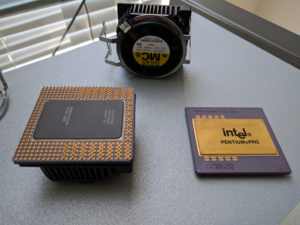erek
[H]F Junkie
- Joined
- Dec 19, 2005
- Messages
- 10,875
As an eBay Associate, HardForum may earn from qualifying purchases.
Follow along with the video below to see how to install our site as a web app on your home screen.
Note: This feature may not be available in some browsers.

Yep, EDO is what I had to use with mine.
This platform was waaaay ahead of its time. I learned a lot during this time period. It was my first PC I built (not my first PC though) and I knocked it out of the park first-try. Was fun playing around with SMP-aware operating systems such as RedHat Linux, Windows NT 4, and even OS/2 Warp 4. Compiling code with ppro optimizations was, oddly enough, satisfying. Although the general software world at the time wasn't really ready for multi-threading.
For those not in the know, this was the first x86 cpu that introduced out-of-order execution and speculative execution (you know, the thing Spectre exploits). We worry about security these days, but this feature alone is what had it leaving regular Pentiums in the dust.
As for gaming, completely ridiculous when paired with Voodoo 2 12MB SLI. It was the golden age of PCs for me. Also had a nice flat 22" Iiyama CRT and played most things at 1024x768 @100Hz.
I'm still mourning my 440FX board committing suicide almost 15 years ago. I never replaced it. However, I still refuse to part with the cpus.
When the PPro launched, the dual socket boards were outrageously priced and rather large. I think I paid $600 (in 90s dollars) for a SuperMicro P6DNF which was a dual socket 8 with 8 ram, 5 PCI, and 3 ISA slots. I ended up pairing it with 2x 200MHz PPro cpus, which were $1000 a piece around launch (yikes!).
The PPro also was rather unique at the time, at least compared to other x86 platforms, in that you also had to install a VRM board alongside the processor. You can see the VRM slots below the socket in the seller's photos.
The PPro also didn't overclock very well. The 200Mhz variants were pretty much maxed out. Unlike the Pentium 2s & Celerons that came after it, the PPro's L2 cache ran at the same speed as the CPU. This often made up somewhat for the clock deficit it had compared to a Pentium 2 233MHz. By the time the Celeron 300As came out, being the efficiency king was over and clock speed was now the new king.
And as it's been stated, the PPro used its own Socket 8 design (Intel went Slot-1 after the PPro). The DEC Alpha was really its only competition in its heyday.
Here's some gratuitous PPro pr0n (yes, that's real GOLD Intel used to cap the cpu, about 1g of it) :
View attachment 163079